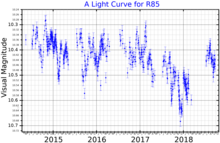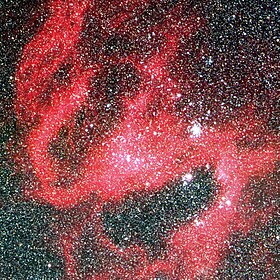R85 (or RMC 85, after the Radcliffe Observatory Magellanic Clouds catalog[5]) is a candidate luminous blue variable[9] located in the LH-41 OB association[10] in the Large Magellanic Cloud.

R85 has been shown to vary erratically in brightness with an amplitude of about 0.3 magnitudes. It shows variations on several timescales, sometimes with a distinct 400 day period. It has also shown temperature changes associated with brightness changes over several years, a characteristic of luminous blue variables.[12]
Based on R85's current properties and evolutionary models, it probably started out with an initial mass of 28 M☉.[10] It is theorized to be making a bubble known as DEM L132a with its stellar wind in the nebula LHA-120 N119, along with S Doradus.[13] It has an infrared excess consistent with a stellar wind contribution.[4]
References[edit]
- ^ a b c d e Cutri, Roc M.; Skrutskie, Michael F.; Van Dyk, Schuyler D.; Beichman, Charles A.; Carpenter, John M.; Chester, Thomas; Cambresy, Laurent; Evans, Tracey E.; Fowler, John W.; Gizis, John E.; Howard, Elizabeth V.; Huchra, John P.; Jarrett, Thomas H.; Kopan, Eugene L.; Kirkpatrick, J. Davy; Light, Robert M.; Marsh, Kenneth A.; McCallon, Howard L.; Schneider, Stephen E.; Stiening, Rae; Sykes, Matthew J.; Weinberg, Martin D.; Wheaton, William A.; Wheelock, Sherry L.; Zacarias, N. (2003). "VizieR Online Data Catalog: 2MASS All-Sky Catalog of Point Sources (Cutri+ 2003)". CDS/ADC Collection of Electronic Catalogues. 2246: II/246. Bibcode:2003yCat.2246....0C.
- ^ a b c d e f g h Ducati, J. R. (2002). "VizieR Online Data Catalog: Catalogue of Stellar Photometry in Johnson's 11-color system". CDS/ADC Collection of Electronic Catalogues. 2237. Bibcode:2002yCat.2237....0D.
- ^ a b c d e f g Van Genderen, A. M. (2001). "S Doradus variables in the Galaxy and the Magellanic Clouds". Astronomy and Astrophysics. 366 (2): 508–531. Bibcode:2001A&A...366..508V. CiteSeerX 10.1.1.459.5400. doi:10.1051/0004-6361:20000022. S2CID 55796300.
- ^ a b c Bonanos, A. Z.; Massa, D. L.; Sewilo, M.; Lennon, D. J.; Panagia, N.; Smith, L. J.; Meixner, M.; Babler, B. L.; Bracker, S.; Meade, M. R.; Gordon, K. D.; Hora, J. L.; Indebetouw, R.; Whitney, B. A. (2009). "Spitzersage Infrared Photometry of Massive Stars in the Large Magellanic Cloud". The Astronomical Journal. 138 (4): 1003–1021. arXiv:0905.1328. Bibcode:2009AJ....138.1003B. doi:10.1088/0004-6256/138/4/1003. S2CID 14056495.
- ^ a b Feast, M. W.; Thackeray, A. D.; Wesselink, A. J. (1960). "The brightest stars in the Magellanic Clouds". Monthly Notices of the Royal Astronomical Society. 121 (4): 337. Bibcode:1960MNRAS.121..337F. doi:10.1093/mnras/121.4.337.
- ^ a b Høg, E.; Fabricius, C.; Makarov, V. V.; Urban, S.; Corbin, T.; Wycoff, G.; Bastian, U.; Schwekendiek, P.; Wicenec, A. (2000). "The Tycho-2 catalogue of the 2.5 million brightest stars". Astronomy and Astrophysics. 355: L27. Bibcode:2000A&A...355L..27H.
- ^ Aldoretta, E. J.; Caballero-Nieves, S. M.; Gies, D. R.; Nelan, E. P.; Wallace, D. J.; Hartkopf, W. I.; Henry, T. J.; Jao, W.-C.; Maíz Apellániz, J.; Mason, B. D.; Moffat, A. F. J.; Norris, R. P.; Richardson, N. D.; Williams, S. J. (2015). "The Multiplicity of Massive Stars: A High Angular Resolution Survey with the Guidance Sensor". The Astronomical Journal. 149 (1): 26. arXiv:1410.0021. Bibcode:2015AJ....149...26A. doi:10.1088/0004-6256/149/1/26. S2CID 58911264.
- ^ Stahl, O.; Wolf, B.; Leitherer, C.; Zickgraf, F.-J.; Krautter, J.; De Groot, M. (1984). "Variable blue supergiants in the Large Magellanic Cloud - R 84, R 85, and R 99". Astronomy and Astrophysics. 140: 459. Bibcode:1984A&A...140..459S.
- ^ Richardson, Noel D.; Mehner, Andrea (2018). "The 2018 Census of Luminous Blue Variables in the Local Group". Research Notes of the American Astronomical Society. 2 (3): 121. arXiv:1807.04262. Bibcode:2018RNAAS...2..121R. doi:10.3847/2515-5172/aad1f3. S2CID 119509358.
- ^ a b Smith, Nathan; Tombleson, Ryan (2015). "Luminous blue variables are antisocial: Their isolation implies that they are kicked mass gainers in binary evolution". Monthly Notices of the Royal Astronomical Society. 447 (1): 598–617. arXiv:1406.7431. Bibcode:2015MNRAS.447..598S. doi:10.1093/mnras/stu2430. S2CID 119284620.
- ^ "ASAS-SN Variable Stars Database". ASAS-SN Variable Stars Database. ASAS-SN. Retrieved 6 January 2022.
- ^ Van Genderen, A. M.; Sterken, C.; De Groot, M. (1998). "Light variations of massive stars (alpha Cyg variables). XVI. The LMC supergiants R 85 (LBV) and R 110 (LBV) and the SMC supergiants R 42 and R 45". Astronomy and Astrophysics. 337: 393. Bibcode:1998A&A...337..393V.
- ^ Ambrocio-Cruz, P.; Rosado, M.; Laval, A.; Le Coarer, E.; Russeil, D.; Amram, P. (2008). "Kinematic field of the S-shaped nebula N119 in the LMC". Revista Mexicana de Astronomía y Astrofísica. 44: 355. Bibcode:2008RMxAA..44..355A.

Well, that’s interesting to know that Psilotum nudum are known as whisk ferns. Psilotum nudum is the commoner species of the two. While the P. flaccidum is a rare species and is found in the tropical islands. Both the species are usually epiphytic in habit and grow upon tree ferns. These species may also be terrestrial and grow in humus or in the crevices of the rocks.
View the detailed Guide of Psilotum nudum: Detailed Study Of Psilotum Nudum (Whisk Fern), Classification, Anatomy, Reproduction